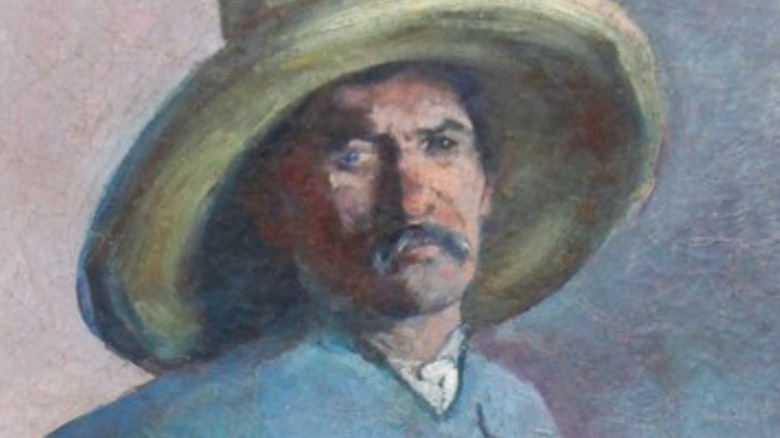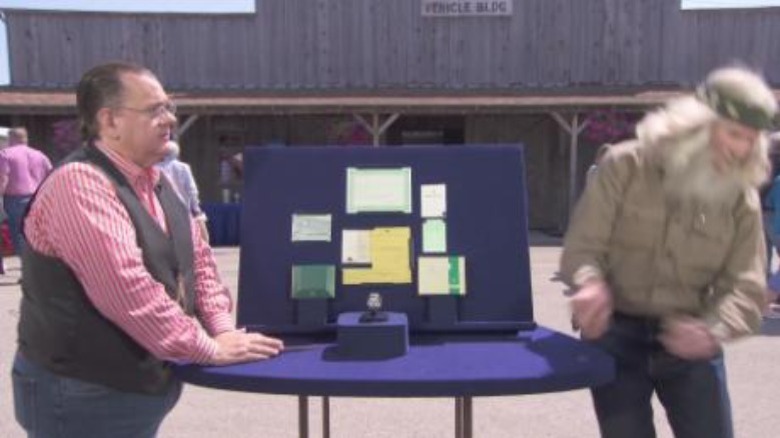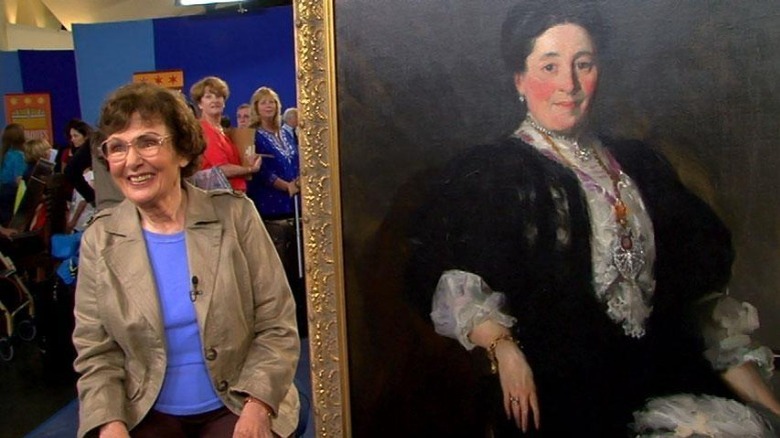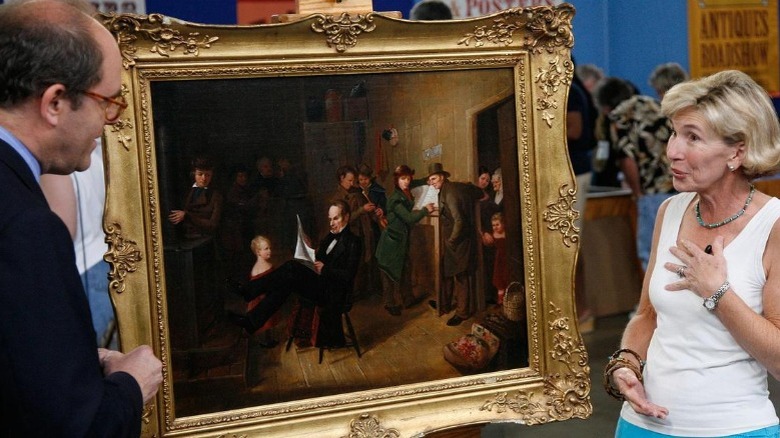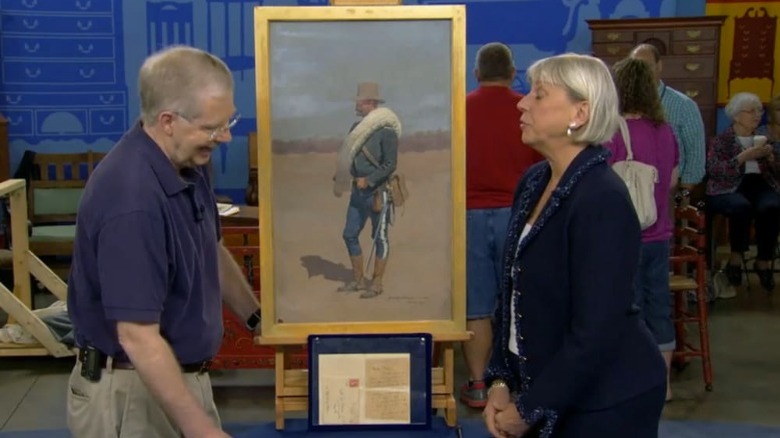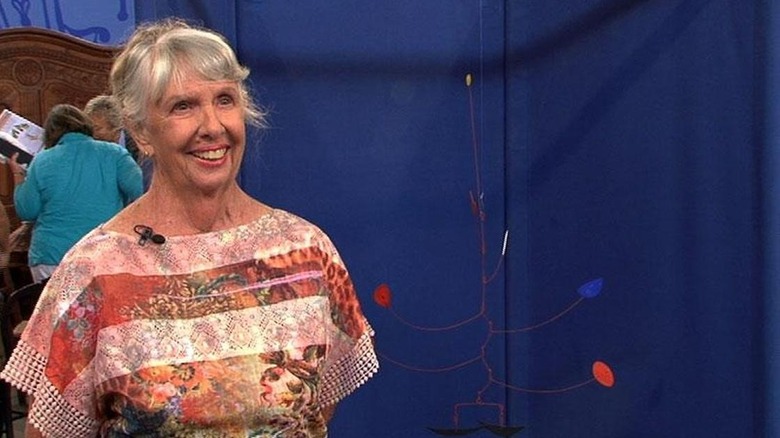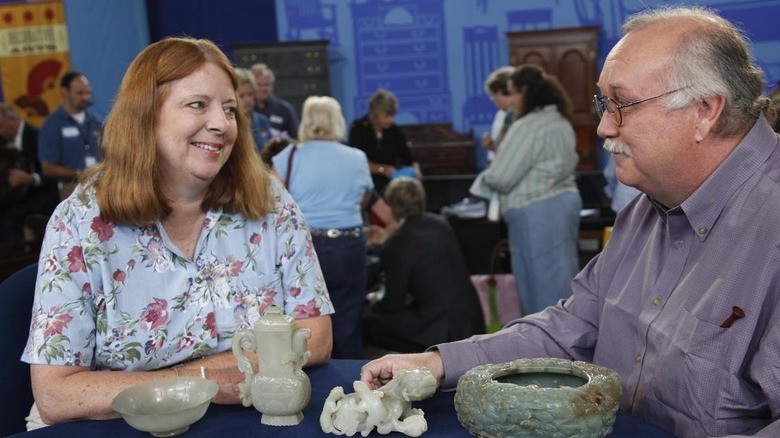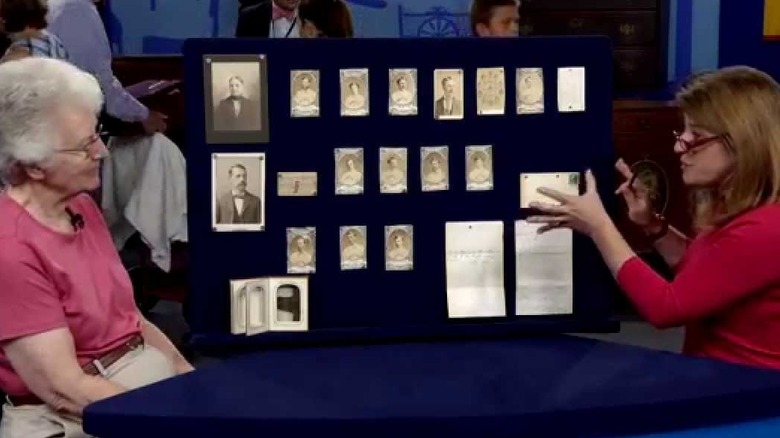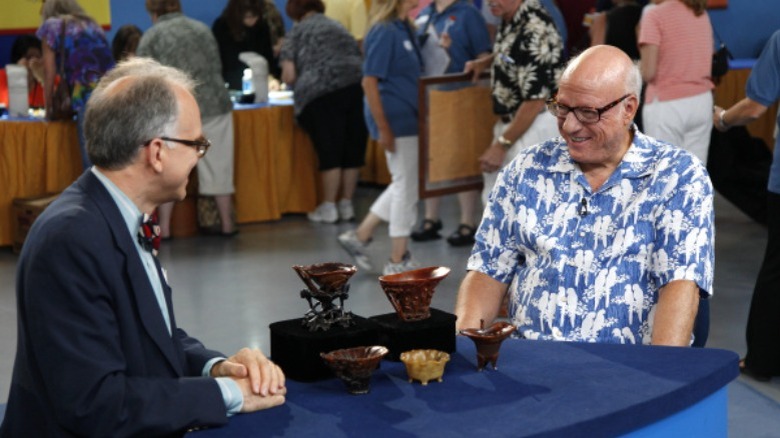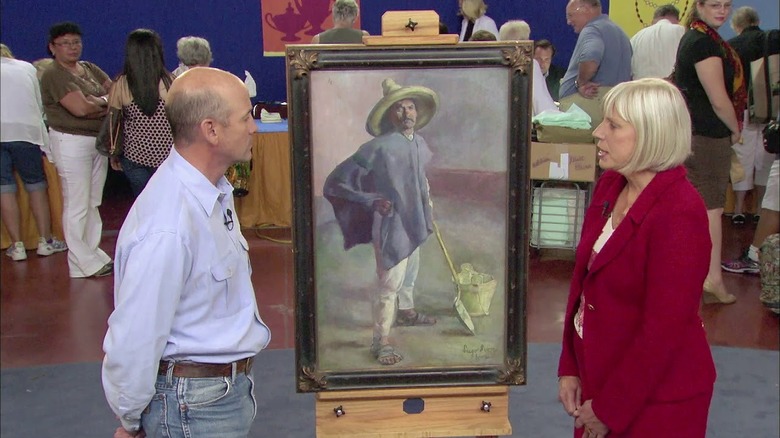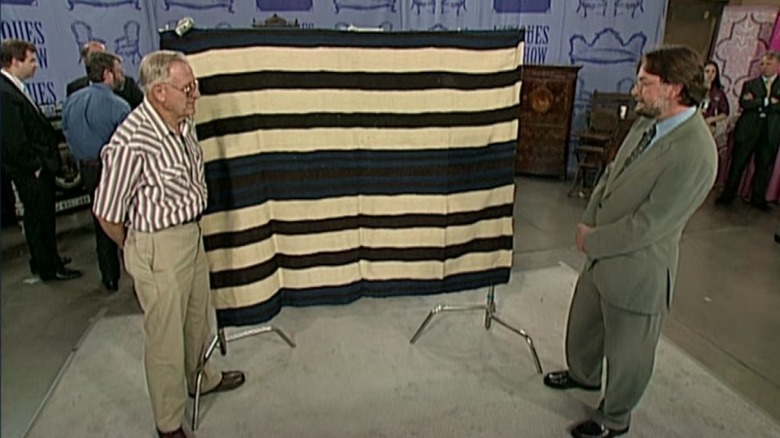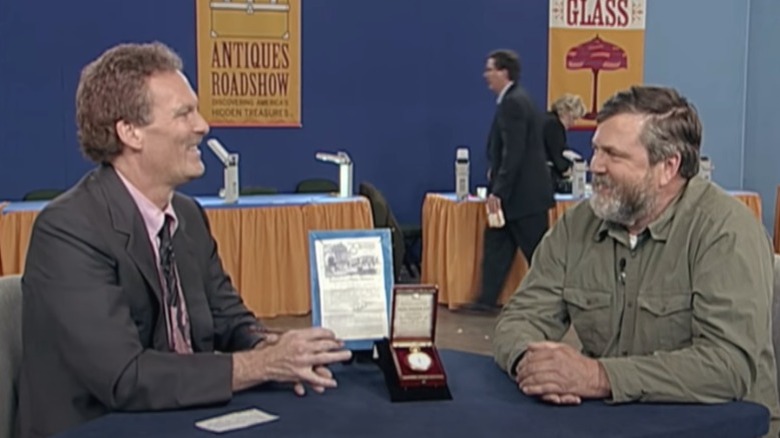The Most Expensive Finds On Antiques Roadshow
Even if you're not a regular PBS viewer, you've probably been flipping channels and ended up watching a bit of "Antiques Roadshow." It's a program that has everything: quirky regular people to enjoy, a level of education that makes you feel like you're learning and not loafing on the couch — but not so much you have to actually think, and the chance to dream someone will bring in an item that will be worth tons of money, and you will sit up slowly, turning your head to look at the exact same item in your own house.
Of course, if you got off the couch once in a while, you could go on "Antiques Roadshow" yourself and finally learn if that vase your grandma picked up at a garage sale for 50 cents was overpriced ... or from the Ming dynasty.
So, who were the people who had that dream come true; who won the lotto in a way that was a lot more fun than just buying a ticket from a gas station? The most expensive items ever valued on the U.S. version of the show come from a wide variety of categories with very different backstories. In some cases, the owners sold their items and came away rich, other times the auction results didn't compare to the valuations, and still others chose to keep their heirlooms in the family or loan them to a museum. These are the most expensive finds on "Antiques Roadshow."
Rolex Oyster Cosmograph watch with documentation, ca. 1971: $500,000 to $700,000
A U.S. Air Force vet appeared on the June 1, 2019 episode of "Antiques Roadshow" in Fargo, North Dakota with a Rolex watch he first purchased while stationed in Thailand in the 1970s. On the plane rides over there, he noticed, "Most of the pilots that were flying those aircraft wore Rolex watches, and I was intrigued by them ... but they were very expensive. I found this particular watch where I could afford it." Despite putting in the effort to find one in his price range, the owner never ended up wearing the beautiful timepiece. "I had other watches I wore and I just put this one into a safety deposit box. It stayed there for 30 or 40 years. I only took it out, like, two or three times to look at it, and that was about the extent of it before I brought it here."
Affordable, even then, was relative, since the Rolex (after a 10% discount) was $345.97, which the vet says was basically a whole month's salary.
It's worth a lot more now though. The appraiser said, "It's one of the rarest Paul Newman models, and in this condition, I don't think there's a better one in the world," and goes on to call it "one of the greatest watches [ever seen] on 'Antiques Roadshow.'" He gave it an auction value of $500,000 to $700,000. The owner can use the cash to build a time machine and go back to thank his younger self for making such a seemingly extravagant purchase, which he didn't know was going to pay off big time.
1907 Robert Henri oil painting: $500,000 to $700,000
The owner of a century-old painting brought it to a San Diego recording of "Antiques Roadshow," which aired on June 12, 2010. The woman explained that the piece of art had been passed down through her family: "This lady is my grandmother ... And the painting was painted by Robert Henri ... a friend of the family ... [She] never worked. I don't think she ever boiled a pot of water for tea." Regardless of if you have to work for a living, this is a lesson that if you know any talented artists, have them paint you, rough hands and all. It's an investment for your grandkids.
But the first appraiser the owner took it to when she inherited the painting in the 1960s didn't think it was impressive. "They said it was not worth much more than Grandpa paid for it, and Grandpa paid $4,500. And the reason it's not worth much more is because it's a family portrait, and museums wouldn't want it and no one else would want it." Right, like how no one likes all those Van Gogh paintings of his mailman, since none of us are related to that guy.
This is why you should never trust a single appraisal (even from the people on "Antiques Roadshow," as we'll see in a bit). This is also an example of why you need to keep your appraisal updated regularly. While the insurance value given on the show in 2010 was $250,000 to $300,000, a 2016 update increased that to $500,000 to $700,000.
1847 James Henry Beard 'The Illustrious Guest' oil painting: $600,000 to $800,000
The owner of the James Henry Beard painting "The Illustrious Guest" brought it to a Dallas, Texas taping of "Antiques Roadshow," which aired on June 28, 2008. Painted in 1847, it depicts Henry Clay, who the appraiser calls the "most recognizable politician of the 19th century next to Abraham Lincoln," popping into a tavern and reading the paper, seemingly oblivious to the patrons all gawking at him. The work had been acquired by the owner's three-times great-grandfather and for a long time the family thought it was by a completely different artist.
The appraiser gave it an auction value of $300,000 to $500,000, which was updated in 2020 to $600,000 to $800,000. He said the painting was so good, it "could hang in a museum."
The owner took him at his word, and soon the painting was on a long-term loan to the Amon Carter Museum of American Art in Fort Worth. The curator, Rebecca Lawton, had even seen the episode and been "intrigued" by the painting. "It is a terrific genre subject that combines fact with fiction," Lawton says. "The setting is accurate, as Clay, a veteran campaigner, certainly would have stopped at country taverns to solicit votes during the 1844 presidential election ... This is a perfect picture of life in antebellum America and a wonderful rediscovery." Considering what it would cost to insure a painting that is worth that much, letting a museum worry about protecting it was probably a very good idea.
1896 Frederic Remington portrait with letter: $600,000 to $800,000
The owner of an 1896 Frederic Remington portrait of his great-grandfather didn't immediately hit it off with the appraiser at the Birmingham, Alabama taping of "Antiques Roadshow" which aired on June 21, 2014. As the appraiser explained once the cameras were rolling, "I've never reprimanded a guest for manhandling a painting before. When you were pulling it out and that foam core was there..."
Fortunately, others in the owner's family were not so sloppy, as the appraiser noted: "Your family's taken very good care of it for a long time. It also comes with this letter from Remington to your great-grandfather. They talk about their adventures that they had. Really, really wonderful." The appraiser gave the picture/letter combo an auction value of $600,000 to $800,000. The owner was in shock, asking, "Can I keep you around so that I take good care of it?"
In an amazing twist discovered after the episode aired, AL.com reports that the director of the Remington Art Museum, Laura Foster went back and looked at records, only to discover that the owner's family had gotten an even better deal than they thought. They'd made a trade with the museum in 1938 to get the painting, giving two of their other Remington pieces in return. Or rather, they traded pictures they thought were by Remington. The museum later discovered the two were forgeries. But the director makes clear it wasn't nefarious. "I just want to say that everybody meant well," Foster said. "In 1938, the world was full of fake Remingtons. Remington has always been a great target for fakes and forgeries."
Alexander Calder Mobile, ca. 1950: $400,000 to $1 million
If you tuned in to the July 10, 2010 episode of "Antiques Roadshow" you might have wondered why a woman brought in a bent wire clothes hanger that she'd hung some guitar picks off of. Well, philistine, you should know that is art. Very expensive and famous art, it turns out.
The owner explained that her family had acquired the piece from the artist, Alexander Calder himself. "My aunt and uncle were having a cocktail party, and Calder was visiting friends of theirs who were invited to the party, so they took Calder along." This is a good point to remind you that if you don't know any famous artists personally, move to the next degree of separation and ask if your friends do. Work those connections. Anyway, she continued, "And my aunt was very creative, and among other things, she had done a needlepoint pillow of one of Calder's works. And he was astounded. He'd never seen one like that before. And so she gave it to him, and a couple of days later, somebody appeared at the doorway, and he had given her this mobile as a thank-you for the pillow."
The appraiser gave the mobile a wide estimate of $400,000 to $1 million, with the low end being an auction value and the million mark being a retail price. While the owner was, of course, shocked and excited, she also immediately thought of the issue that many parents with pricey and/or sentimental heirlooms realize they have: "Oh! My problem is, I've got one mobile and two children."
18th-century Qianlong jade collection from the Qing Dynasty: $710,000 to $1.07 million
The Raleigh, North Carolina episode that aired on June 27, 2009 is a legendary one in "Antiques Roadshow" history. A woman brought in a collection of decorative jade objects from the 1700s, which her father had purchased when he was stationed in China in the 1930s and '40s. The appraiser gave the collection an auction value of $710,000 to $1.07 million, and while that might not seem important since we're only halfway through this list, it was the first time ever something on the show was given a value over the million mark.
Major news outlets like Reuters covered the record-breaking valuation, with executive producer Marsha Bemko telling them, "For 13 years, we've been hoping to feature a million-dollar appraisal on 'Antiques Roadshow;' it's been our 'Great White Whale.' We're thrilled that, despite this year's slow economy, 'Roadshow' finally captured this elusive trophy."
Ah, but you know what they say. They say a couple things that relate to this story, actually: Don't count your chickens before they are hatched; and something is only worth what someone is willing to pay for it. It turned out that while the collection could theoretically be worth over that million mark, in an actual auction, they went for less than half. Current reports the pieces that were on "Antiques Roadshow" sold for $494,615, while 30 additional pieces the owner had but hadn't brought on the show sold for $350,523, so even combined, they didn't hit that high estimate.
1871-1872 Boston Red Stockings archive: $1 million
It's always nice to see something a bit different on "Antiques Roadshow," especially when there's a documented history and provenance behind it. So it was with an amazing collection of what were basically the earliest type of baseball cards that appeared on the January 5, 2015 episode. The owner explained how they had come into her family a very long time ago, "Back in 1871, my great-great-grandmother had a boarding house in Boston, and she housed the Boston baseball team. Most of them had come from Cincinnati Red Stockings and were among the first to be paid to play baseball ... And the thing that's special, in addition to the cards, is this letter, and they all wrote a little sentence and signed it."
While the discovery of the baseball cards was amazing, the appraiser also loved the letter, where it became clear the players mostly thought about food: "I'm sure she did the cooking, the cleaning for them. Because if you read some of these lines here: 'I am just going upstairs to supper and feel awful hungry, but do not expect much– poor meals here, too hungry to say any more, Harry Wright.'"
The owner said she'd once been offered $5,000 for the collection, and she needs to thank every deity possible she didn't sell. Calling it "the greatest archive I have ever had at the Roadshow" and choking up as she said it, the appraiser values the whole collection at an insurance value of $1 million.
Chinese rhinoceros horn cups, ca. 1700: $1 million to $1.5 million
The collection of five cups an owner brought on the Tulsa, Oklahoma episode of "Antiques Roadshow" that aired on July 23, 2011 were always going to be controversial. That's because they were all made out of rhino horn. You might know rhinos as super endangered, and that making things out of their horns is as frowned on (not to mention illegal) as it is to carve up ivory. Since these cups had been made around 1700, most places consider them legally acceptable, but with a side eye.
The owner, though, absolutely loved them, and collected them in the 1970s and '80s. He told the appraiser, "This one that I bought in England was $500, and that took almost all the money I had with me to buy that one. So it was kind of a cheap trip the rest of the time I was there. This one I had to put two credit cards and some cash together to buy it." The owner said it was all worth it: "I'd rather collect something like this than eat."
The appraiser said the collection of cups would be worth $1 million to $1.5 million at auction, at the time a record for the show. But this is another one of those times where a theoretical value didn't become reality. Perhaps because of their controversial material, the New York Post reported they were a "flop" at auction, with only two of the five even selling: "One cup sold for $146,500, while the other cup went for $182,500."
1904 Diego Rivera 'El Albañil' oil painting: $1.2 million to $2.2 million
The painting of a stern looking man in a Mexican-style hat and poncho that was on the Corpus Christi, Texas episode that aired August 4, 2012 might not have seemed like much at first. Sure, it was nice enough, and the artist was obviously talented, but the owner's family must not have been blown away by it, considering where they hung it for years. He said, "The painting for some time was in bad condition, and it was hanging behind a door ... If that door was open, then you couldn't see the painting." Still, they must have liked it a bit, because they kept it for over eight decades.
It must have been quite well hidden behind that door, because it turned out this painting was lost, as in art experts knew it existed but didn't know where it was. As the appraiser explained, "There are two extraordinarily intriguing words in an artists' catalogue of paintings. And those are: whereabouts unknown. The research that we found in the authentication process of it is that it had been missing. In the records in Mexico City, it was unknown. Where's the painting? Where is 'El Abañil?'"
That's because this was no ordinary painting, but an early work by none other than Diego Rivera. The appraiser gave it a retail value of $800,000 to $1 million, and it's since been updated to $1.2 to $2.2 million. Obviously realizing the cultural importance of the painting, the owner arranged for it to be on permanent loan to the San Antonio Museum of Art.
Navajo Ute First Phase blanket, ca. 1850: $1.5 million to $2 million
The Navajo blanket episode of "Antiques Roadshow," which was filmed in Tucson, Arizona and aired on June 9, 2001, has gone down in history, so that even people who aren't familiar with the show might know about it. The owner of a rather plain but beautiful blanket told the appraiser, "I don't know an awful lot about it, except that it was given by Kit Carson– who I'm sure everybody knows, and his history– given to the foster father of my grandmother."
The appraiser was interested in the Kit Carson connection, but since the owner had no proof of it, at least at that time, it couldn't really be included in the theoretical value. It didn't matter in the slightest. The owner got his first inkling the blanket was special when the appraiser said, "When you showed this to me ... I kind of stopped breathing a little bit." He'd go on to call it a "national treasure" and reiterated, "When you walked in with this, I just about died."
So when the appraiser asked the owner "Are you a wealthy man, Ted?" that audience sat on the edge of their seats. Ted, it turned out, was not rich. The appraiser continued, "Well, sir, um... I'm, I'm still a little nervous here, I have to tell you. On a really bad day, this textile would be worth $350,000. On a good day, it's about a half a million dollars." Updates over the past two decades have increased that number to $1.5 to $2 million.
1914 Patek Philippe pocket watch: $2 million to $3 million
The name Patek Philippe automatically means lots of dollar signs. So the watch an owner brought to the St. Paul, Minnesota episode that aired on June 26, 2004, was always going to have an impressive value. But even then, this one surpassed all expectations. The owner explained how it came to be in his family, "This watch was handed down from my great-grandfather. He was the owner of the 'St. Paul Pioneer Press and Dispatch' back in 1914, when he received this watch. And it was handed down from him to my father, and then he gave it to me."
While Artful Living reports the owner was hoping it was worth maybe $50,000, the appraiser had a heck of a surprise for him: "Patek Phillipe is now purchasing those watches for their museum. This watch, at auction, I suspect would bring close to a quarter million dollars." He continued, "It's the finest watch I've ever held in my hand ... I've never seen anything like it, other than photos." But this valuation would end up being far too low.
The owner immediately realized that the absurdly valuable watch presented him with multiple problems, the most pressing being: "Oh, my gosh, how do I get it home?" The second problem — who to leave the watch to without causing a major rift in the family — was solved when he auctioned the watch off at Sotheby's in 2006 for $1,531,760. "How was I ever going to cut a watch up into 15 pieces?" he asked. The Roadshow website estimates that as of 2018 the watch is now worth $2 million to $3 million.
